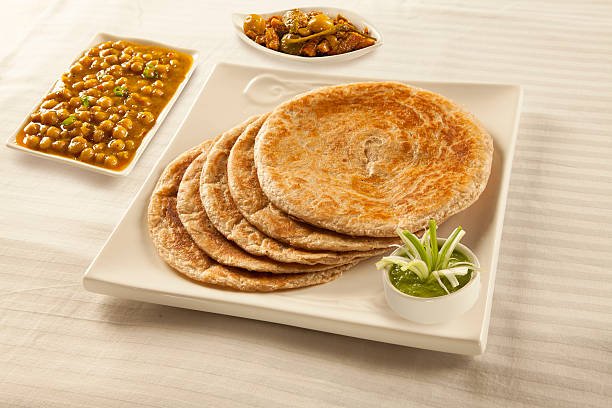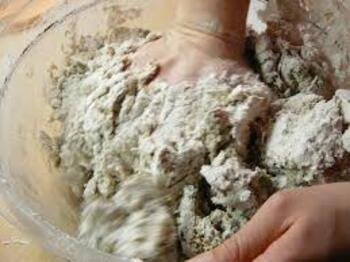What is Paratha?| What is Lachha Paratha?
Paratha and Lachha Paratha both delicious and versatile flatbreads enjoyed throughout South Asia and beyond.
Paratha
A paratha is a delectable flatbread typically made with whole wheat flour, water, salt, and ghee (clarified butter) or oil. Sometimes a small quantity of yogurt is added to the dough to make the parathas soft. The dough is then rolled out into a circle, square, or triangle. After shaping, it is cooked on a hot tava or griddle with butter, ghee, or oil.
Lachha/Laccha Paratha
Lachha paratha is a type of layered flatbread that can be enjoyed in various ways. After rolling out the dough balls into a circle, they are folded multiple times using unique techniques to form layers. The paratha is then cooked on a hot tava or griddle with butter, ghee, or oil.

Lachha Paratha Ingredients
Whole Wheat Flour-The base ingredient for the dough, providing a hearty and wholesome texture.
Salt– Enhances the flavor of the paratha.
Ghee or Oil– Used for creating the layers and cooking, adding richness and crispiness.
Water– Helps in forming a smooth and pliable dough.
Optional: Ajwain or Carom Seeds-Adds a subtle, aromatic flavor to the paratha.
Different types of Parathas
Parathas come in a variety of styles, each with its own unique name and flavor profile.
Plain Paratha
The simplest form of parathas is known as plain paratha. Where the dough is simply rolled out and cooked on griddle with ghee or oil. This can be enjoyed in its simple, unleavened glory or can make your favorite paratha roll.
Lachha Paratha
Also known by many names like Kerala Parotta, Roti Canai, or Malabar Parotha, this type of paratha has many flaky layers created by a special folding and rolling technique.
This delicious flatbread is known by two names in Jamaica: buss up shut and paratha roti. It’s known for its flaky layers and can be enjoyed in several ways.
Flavored Parathas
For an extra flavor boost, spices or other aromatics herbs veggies or cooked lentils can be incorporated into the dough.
Stuffed Parathas
Packed with savory fillings. These parathas are a complete meal in themselves.However the true magic lies in the endless possibilities for fillings and variations of stuffed parathas like
Aloo Paratha (potato stuffed flatbread)
Paneer Paratha (Cheese stuffed flatbread)
Gobi Paratha (Cauliflower stuffed flatbread)
Chicken Paratha (chicken stuffed flatbread)
keema paratha (ground beef/mutton stuffed flatbread)
Meetha Paratha (sweet flatbread )
Mooli Paratha (radish stuffed flatbread)
Methi Paratha (fenugreek stuffed flatbread)
Pyaz Paratha (onion stuffed paratha)
Daal Paratha or lentil stuffed flatbread etc.
Paratha vs. Naan
Paratha is a layered, flaky flatbread made with whole wheat flour, often cooked with ghee or oil on a tava (griddle). It can be stuffed with various fillings and is typically softer with a crisp exterior.
Naan is soft, leavened flatbread made with all-purpose flour and yogurt, traditionally cooked in a tandoor (clay oven). It’s thicker, fluffier, and often served with a charred exterior.
Frozen Parathas
Having frozen paratha on hand means you can quickly prepare a meal without starting from scratch.You can make a large batch of lachha parathas and freeze them for later enjoyment.
Rollout the Folded or layered dough balls into parathas, separate these uncooked parathas with parchment paper to prevent sticking. Wrap each paratha individually.Place the wrapped paratha in freezer bag, removing as much air as possible.
How Flour and Water Create Paratha Perfection

Kneading the dough is the first step of making flatbread. Its dough should not be hard or sticky. To get the perfect dough consistency water is our secret ingredient, but the amount of water required for a perfect paratha dough isn’t a fixed quantity. The type of flour you choose really makes a difference in how your paratha turns out. Flour with higher fiber content tend to absorb more water due to the increased surface area of the fiber particles.
Pro tips for best lachha paratha
- Resting the dough helps in making the parathas soft and easier to roll.
- Always cook paratha on medium to high heat; cooking on low heat can make it hard.
- Use ghee for a richer taste and flakier layers. Adjust the amount of oil or ghee based on your preference for crispiness. Practice makes perfect, so don’t worry if the first few parathas aren’t perfect.
- This paratha recipe is your personal roadmap to achieving crispy perfection. We’ll walk you through every step, from kneading the dough to mastering the cooking technique, ensuring you create deliciously flaky parathas every time. Let’s Explore our step-by-step guide on how to make Lachha Paratha:
FAQs
What is the difference between paratha and roti?
Roti-This is a simple, unleavened flatbread from India. It’s cooked on a flat pan or open flame and has a soft texture.
Paratha– This is a layered flatbread, also from India. It’s made with a dough that’s folded and cooked with oil or ghee, giving it a flaky texture and richer flavor.
What to eat with Laccha/lachha paratha?
Laccha paratha can be enjoyed simply with a pat of butter and a hot cup of tea for a comforting snack or light meal.
You can also explore chutneys like mint or coriander chutney and tangy pickle like mango or lime pickle to add a delicious contrast.
Pair it with all types of vegetable or chicken curries, kebabs, chana masala, omelette or enjoy it with flavorful dals like dal makhani.
What is Lachha paratha made of?
Lachha Paratha are crispy, flaky, layered whole wheat flatbreads made with a simple unleavened dough consisting of whole wheat flour, salt, and ghee or oil. They are a popular variant of paratha from the North Indian cuisine.
Lachha Paratha| Indian Layered Flatbread
Description
Paratha is a simple, unleavened flatbread from India. It is made with whole wheat flour/ all-purposed flour dough that's rolled out thin and folded multiple times to form layers and cooked on a griddle with oil or ghee.
Ingredients
Lachha Paratha Recipe
-
kneading the dough:
In a large bowl, combine the flour, salt and oil then slowly add the water in portions, mixing until a dough forms. If it feels too dry or sticky, adjust the water a little at a time. Knead the dough with soft hand for about about 5-10 minutes, or until smooth and elastic. If it feels too dry or sticky, adjust the water a little at a time
-
Rest the dough:
After kneading the dough cover it with a damp kitchen towel and let it rest for 30 minutes .This allows the gluten to relax and makes it easier to roll out later
-
Divide the dough:
Divide the dough into 7-8 equal parts, about the size of golf balls.
On a lightly floured surface, roll out each part of dough into a medium-sized ball . Dust with flour and flatten on a clean surface that’s also dusted with a bit of flour.
-
Roll out the dough Balls:
With rolling pin roll out the each dough ball into a thin circle , approximately 6-7 inches in diameter.
-
Apply ghee or oil :
Brush the clarified butter or oil on the whole surface of rolled dough.
-
Foldng techniques ofdough:
Method 1: For Square Paratha
Fold the 1/3 part of rolled dough from both side. Again brush the folded strip of dough and fold 1/3 part of it from both sides. Now roll out the dough again with soft hands into square paratha.
-
Method 2: For Round Paratha
With rolling pin roll out the each dough ball into a thin circle , approximately 6-7 inches in diameter.
Brush the purified butter or oil on the whole surface of rolled dough.
Now lift the one edge of rolled dough and fold it like chines fan then stretch it length wise and roll like a cinnamon roll and secure the edges.
-
Cook :
- Heat a griddle (tawa) over medium heat. Once hot, place the rolled flatbread on the griddle.When you see bubbles on the surface of the paratha, flip it and gently spread ghee or oil over it using your spatula..
- Cook for 6-7 seconds or until golden brown then flip again and repeat the same process on the other side until golden brown and slightly puffed. You can press down gently with a spatula to ensure even cooking.It will take hardly 5 minutes to cook perfect golden,crispy,lachha parotha
-
Serving suggestions:
-
Enjoy the paratha on its own, perhaps with a dollop of butter or ghee for richness.
-
Pair your paratha with yogurt, pickles, Chana masala,halwa(samolina pudding) or chutney for a flavorful combination.
-
Paratha makes a fantastic accompaniment to all sorts of curries, be it chicken Karahi, lamb, vegetable, or any other favorite.
-
Enjoy paratha for breakfast alongside fried eggs, scrambled eggs or another morning dish.
-
Stuff your paratha with grilled meats or vegetables with your favorite sauces to make your satisfying paratha rolls.
-
Nutrition Facts
- Amount Per Serving
- Calories 180kcal
- % Daily Value *
- Total Fat 5g8%
- Total Carbohydrate 25g9%
- Dietary Fiber 4g16%
- Protein 5g10%
* Percent Daily Values are based on a 2,000 calorie diet. Your daily value may be higher or lower depending on your calorie needs.
Note
- The Finger Test: To assess the dough's softness, gently press your finger into it.
- Keep a watchful eye: Overcooking can make your paratha dry and tough. Aim for golden brown spots with a slight puff for a perfect texture.
- Start small: Add water in small increments, allowing the flour time to absorb it before adding more.
- To ensure a smooth and elastic dough, place it in an airtight container or cover it with a damp kitchen towel.
- Don't forget to apply a thin layer of oil on dough balls before cover them to rest.












